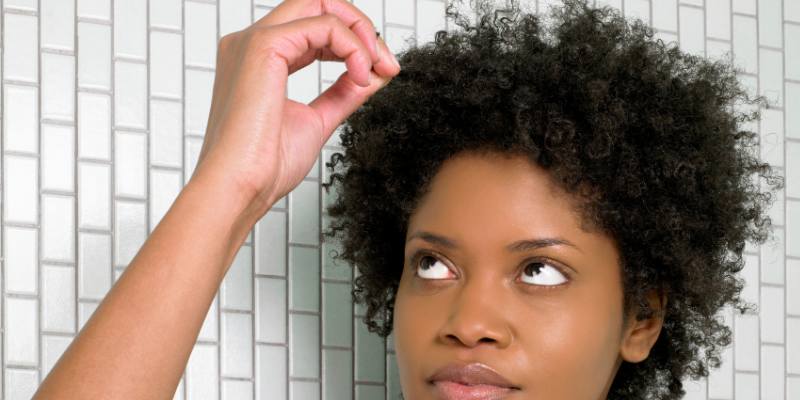We all have our quirks.
Maybe you bite your nails, tap your foot, or twirl a strand of hair when you're concentrating.
But for some people, hair pulling goes beyond a nervous habit and becomes a compulsive behavior known as Trichotillomania (TTM).
Understanding Trichotillomania
TTM is a mental health condition characterized by the recurrent urge to pull out hair from your scalp, eyebrows, or other areas of the body.
Unlike a simple habit, TTM involves a sense of mounting tension before pulling, followed by temporary relief or gratification after.
The hair pulling can be focused or unfocused.
Focused pulling involves deliberate targeting of specific areas, while unfocused pulling may be more automatic, happening almost unconsciously while watching TV, reading, or stressed.

What Causes Trichotillomania?
The exact cause of Trichotillomania is unknown, but it's likely a combination of factors, including:
- Genetics: A family history of TTM or obsessive-compulsive disorder (OCD) may increase the risk.
- Neurological factors: Brain abnormalities in the areas associated with habit formation and impulse control might play a role.
- Psychological factors: Stress, anxiety, and emotional distress can trigger TTM episodes.
Living with Trichotillomania: Beyond the Hair Loss
Hair loss is a visible symptom of TTM, but it's not the only challenge.
People with TTM often experience:
- Shame and embarrassment: The social stigma surrounding hair loss can lead to feelings of isolation and withdrawal.
- Anxiety and depression: TTM can exacerbate underlying anxiety or contribute to developing depression.
- Difficulty concentrating: The urge to pull hair can be distracting and interfere with daily activities.
Breaking the Cycle: Treatment Options for TTM
Fortunately, TTM is treatable.
Here are some effective approaches:
- Cognitive-behavioral therapy (CBT): CBT helps identify triggers, develop coping mechanisms for managing urges, and replace hair pulling with healthier behaviors.
- Habit reversal training: This CBT technique teaches you to recognize the urge to pull hair and substitute with a different, incompatible response, like clenching your fist.
- Medication: Antidepressants, particularly selective serotonin reuptake inhibitors (SSRIs), may be helpful in some cases, particularly when TTM co-occurs with anxiety or depression.
Trichotillomania can be a challenging condition, but with the right support and treatment, you can find relief and manage your urges. Hair pulling doesn't define you, and recovery is possible. Take a step towards a healthier, happier you, and don't hesitate to reach out for help.

Our team at Wig Medical consists of certified cranial prosthesis specialists. Their rigorous training ensures a perfect fit for your wig, resulting in a natural-looking solution that prioritizes your comfort and self-assurance.
We offer a diverse selection of premium wigs in various styles, materials, and colors, allowing you to find the perfect match for your personality and preferences.
Navigating insurance coverage for wigs can be complex.
However, our team possesses the expertise to guide you through the process, maximizing your potential for coverage benefits.
We believe in personalized care and support throughout your experience. We actively listen to your concerns, address your questions with clear explanations, and provide expert guidance every step of the way.
Contact a member of our professional team today!
Five Things You Should Know about Trichotillomania
What are some coping strategies for managing urges to pull hair in trichotillomania?
Developing effective coping strategies is crucial for managing trichotillomania.
Some techniques include:
- Activity replacement: Engage hands in other activities like knitting, drawing, or squeezing a stress ball when the urge to pull arises.
- Barrier methods: Wear gloves, hats, or bandages to physically prevent pulling and to serve as a reminder to stop.
- Mindfulness and relaxation techniques: Practices such as yoga, meditation, and deep breathing can help reduce the anxiety that might trigger hair pulling.
- Setting clear goals and monitoring progress: Keeping a journal to track progress and triggers can provide insights into patterns of hair pulling, helping to develop more targeted interventions.
- Professional therapy: Regular sessions with a therapist can provide emotional support and more personalized strategies for dealing with the impulses.

What causes trichotillomania?
The exact cause of trichotillomania is not known.
It is believed to be the result of a combination of genetic, neurological, and environmental factors.
Some people may start hair-pulling as a way to relieve stress or anxiety, while others may not notice they are pulling their hair when they are bored, reading, or watching TV.
What are the symptoms of trichotillomania?
Symptoms include:
- Repeatedly pulling out hair, resulting in noticeable hair loss.
- Tension before pulling or when trying to resist pulling.
- Pleasure, gratification, or relief after pulling.
- Presence of bare patches where hair has been pulled out.
- Significant distress or impairment in social, occupational, or other areas of functioning.
How is trichotillomania diagnosed and treated?
Diagnosis typically involves a medical evaluation to rule out other causes of hair loss, followed by an assessment from a mental health professional.
Treatment may include:
- Behavioral therapy: Cognitive-behavioral therapy (CBT) techniques such as habit reversal training can help manage the urge to pull hair.
- Medication: Some antidepressants or medications used for treating obsessive-compulsive disorder may be effective.
- Support groups: Connecting with others who have trichotillomania can provide emotional support and coping strategies.
Can hair grow back after stopping hair-pulling behavior?
Hair regrowth depends on the extent and duration of pulling. If the hair follicle is not severely damaged, hair will likely grow back over time.
However, chronic pulling can sometimes damage follicles permanently, preventing regrowth.

